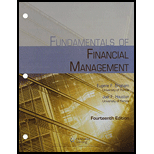
Bundle: Fundamentals of Financial Management, Loose-leaf Version, 14th + LMS Integrated for MindTap Management, 2 terms (12 months) Printed Access Card
14th Edition
ISBN: 9781305777217
Author: Eugene F. Brigham, Joel F. Houston
Publisher: Cengage Learning
expand_more
expand_more
format_list_bulleted
Question
Chapter 4, Problem 14P
Summary Introduction
To determine:
Return on Equity: Return on equity represents the amount of return earned by equity share holders; it can be calculated by dividing earnings available for equity shareholders to total equity capital.
Expert Solution & Answer
Want to see the full answer?
Check out a sample textbook solution
Students have asked these similar questions
3 years ago, you invested $9,200. In 3 years, you expect to have $14,167. If you expect to earn the same annual return after 3 years from today as the annual return implied from the past and expected values given in the problem, then in how many years from today do you expect to have $28,798?
Please Don't use Ai solution
Ends Feb 2
Discuss and explain in detail the "Purpose of Financial Analysis" as well as the two
main way we use Financial Ratios to do this.
Chapter 4 Solutions
Bundle: Fundamentals of Financial Management, Loose-leaf Version, 14th + LMS Integrated for MindTap Management, 2 terms (12 months) Printed Access Card
Ch. 4 - Financial ratio analysis is conducted by three...Ch. 4 - Prob. 2QCh. 4 - Over the past year, M.D. Ryngaert Co. had an...Ch. 4 - Profit margins and turnover ratios vary from one...Ch. 4 - How does inflation distort ratio analysis...Ch. 4 - Prob. 6QCh. 4 - Give some examples that illustrate how (a)...Ch. 4 - Why is it sometimes misleading to compare a...Ch. 4 - Suppose you were comparing a discount merchandiser...Ch. 4 - Prob. 10Q
Ch. 4 - Differentiate between ROE and ROIC.Ch. 4 - Prob. 12QCh. 4 - DAYS SALES OUTSTANDING Baker Brothers has a DSO of...Ch. 4 - DEBT TO CAPITAL RATIO Bartley Barstools has a...Ch. 4 - DuPONT ANALYSIS Doublewide Dealers has an ROA of...Ch. 4 - MARKET/BOOK RATIO Jaster Jets has 10 billion in...Ch. 4 - PRICE/EARNINGS RATIO A company has an EPS of 2.00,...Ch. 4 - DuPONT AND ROE A firm has a profit margin of 2%...Ch. 4 - Prob. 7PCh. 4 - DuPONT AND NET INCOME Ebersoll Mining has 6...Ch. 4 - BEP, ROE, AND ROIC Duval Manufacturing recently...Ch. 4 - M/B AND SHARE PRICE You are given the following...Ch. 4 - RATIO CALCULATIONS Assume the following...Ch. 4 - RATIO CALCULATIONS Graser Trucking has 12 billion...Ch. 4 - TIE AND ROIC RATIOS The H.R. Pickett Corp. has...Ch. 4 - Prob. 14PCh. 4 - RETURN ON EQUITY AND QUICK RATIO Lloyd Inc. has...Ch. 4 - Prob. 16PCh. 4 - CONCEPTUAL: RETURN ON EQUITY Which of the...Ch. 4 - TIE RATIO AEI Incorporated has 5 billion in...Ch. 4 - CURRENT RATIO The Petry Company has 1312,500 in...Ch. 4 - DSO AND ACCOUNTS RECEIVABLE Harrelson Inc....Ch. 4 - P/E AND STOCK PRICE Fontaine Inc. recently...Ch. 4 - BALANCE SHEET ANALYSIS Complete the balance sheet...Ch. 4 - RATIO ANALYSIS Data for Barry Computer Co. and its...Ch. 4 - DUPONT ANALYSIS A firm has been experiencing low...Ch. 4 - RATIO ANALYSIS The Corrigan Corporations 2014 and...Ch. 4 - Prob. 26ICCh. 4 - Conducting a Financial Ratio Analysis on HP INC....Ch. 4 - Conducting a Financial Ratio Analysis on HP INC....Ch. 4 - Prob. 3TCLCh. 4 - Conducting a Financial Ratio Analysis on HP INC....Ch. 4 - Conducting a Financial Ratio Analysis on HP INC....Ch. 4 - Conducting a Financial Ratio Analysis on HP INC....Ch. 4 - Conducting a Financial Ratio Analysis on HP INC....Ch. 4 - Conducting a Financial Ratio Analysis on HP INC....
Knowledge Booster
Similar questions
- Nikes annual balance sheet and income statement for 2022-2023 and 2024arrow_forwardWhat is the value at the end of year 3 of a perpetual stream of $70,000 semi-annual payments that begins at the end of year 7? The APR is 12% compounded quarterly.arrow_forwardFirm A must pay $258,000 to firm B in 10 years. The discount rate is 16.44 percent per year. What is the present value of the cash flow associated with this arrangement for firm A? -I got the answer of 56331.87773=56332 (rounded to the nearest dollar), but it says incorrect.arrow_forward
- Suppose you have two histograms: one where the mean equals the median, and one where the mean is different from the median. How would you expect the two histograms to differ.arrow_forward(a) The variables have been stripped of their names. Which one do you think is "household income" ?(b) Calculate the mean, median, and standard deviation of household income. Do these numbers fit with your expectations? (c) Suppose you have two histograms: one where the mean equals the median, and one where the mean is different from the median. How would you expect the two histograms to differ?arrow_forwardJanet Foster bought a computer and printer at Computerland. The printer had a $860 list price with a $100 trade discount and 210210 , n30n30 terms. The computer had a $4,020 list price with a 25% trade discount but no cash discount. On the computer, Computerland offered Janet the choice of (1) paying $150 per month for 17 months with the 18th payment paying the remainder of the balance or (2) paying 6% interest for 18 months in equal payments. Assume Janet could borrow the money for the printer at 6% to take advantage of the cash discount. How much would Janet save? Note: Use 360 days a year. Round your answer to the nearest cent.arrow_forward
arrow_back_ios
SEE MORE QUESTIONS
arrow_forward_ios
Recommended textbooks for you
 EBK CONTEMPORARY FINANCIAL MANAGEMENTFinanceISBN:9781337514835Author:MOYERPublisher:CENGAGE LEARNING - CONSIGNMENT
EBK CONTEMPORARY FINANCIAL MANAGEMENTFinanceISBN:9781337514835Author:MOYERPublisher:CENGAGE LEARNING - CONSIGNMENT Intermediate Financial Management (MindTap Course...FinanceISBN:9781337395083Author:Eugene F. Brigham, Phillip R. DavesPublisher:Cengage Learning
Intermediate Financial Management (MindTap Course...FinanceISBN:9781337395083Author:Eugene F. Brigham, Phillip R. DavesPublisher:Cengage Learning

EBK CONTEMPORARY FINANCIAL MANAGEMENT
Finance
ISBN:9781337514835
Author:MOYER
Publisher:CENGAGE LEARNING - CONSIGNMENT


Intermediate Financial Management (MindTap Course...
Finance
ISBN:9781337395083
Author:Eugene F. Brigham, Phillip R. Daves
Publisher:Cengage Learning